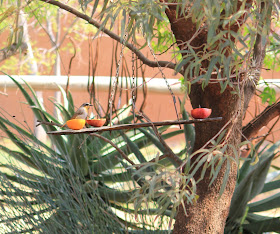Sir John Lubbock :
Rest is not idleness, and to lie sometimes on the grass on a summer day listening to the murmur of water, or watching the clouds float across the sky, is hardly a waste of time.
Rest is not idleness, and to lie sometimes on the grass on a summer day listening to the murmur of water, or watching the clouds float across the sky, is hardly a waste of time.
Up early this morning, about 5am - after yesterday's wintry weather, a forecast of 24℃ promised a beautiful day ahead. I decided to take a walk along the perimeter of the fence around our smallholding and it revealed a few lovely surprises. I came upon this section of our fence that seemed to be highly prized by the termites! Not only had they almost decimated my lawn this winter, it seems nothing is beyond their reach. So obviously these poles will have to be replaced, there were about seven of them, and we will also have to paint all the wooden ones with Creosote. In case you're not familiar with Creosite, it is the portion of chemical products obtained by the distillation of a tar that remains heavier than water, notably useful for its anti-septic and preservative properties. It is black in colour with an extremely strong tar smell and is great for keeping any wood safe from insects.
I also came across some lovely wild flowers. This beauty looks SO much like a potato flower I was almost tempted to dig it up!
Circling around the back of the house, I passed Solly (our mechanic and general factotum) at the borehole pump, filling up the water tanks. We stood for a while, chatting, and he told me has going to tend his vegetable patch today, as well is fix his chicken coop as the neighbours' dogs had already killed four of his chickens.
I said goodbye and as I approached the blue gum bush, I spotted a little patch of grass and some Dandelions - these little flowers (I call them flowers, not weeds) always seem to catch my attention, so I stopped and took a couple of photos.
Returning around the other side of the house, I just had to stop and take a photo of my Avocado tree. Believe it or not, but this tree was started with an Avo pip in a glass of water, transplanted several times into different size pots and eventually, when it was too big for any pot, I planted it here next to one of our water tanks. A Privet sprung up next to it, but I've left it as it somewhat protects the Avo from frost during the winter. It has never borne any fruit and is about 8m high now. The Avo tree is on the right.
Mid-morning we took a drive out to Magaliesburg Country Hotel for their stunning breakfast buffet they serve on Sundays and spent a relaxing morning with hubby reading the Sunday papers and me reading my favourite blogs on my Samsung Galaxy tablet, sharing news as we sat sipping our coffees.
On our drive home, we stopped at one of the many little dams dotting the route and I fed the Coots, who always love the bread I take along with me (this time pinched from the toast basket at breakfast!)
Upon our return, there was an Egyptian Goose sitting on the wall next to the gate, letting her discontent be known as as the car stopped, but amazingly, she never flew off and I managed a quick shot before pulling the car into the driveway.
How did you spend your Sunday?
::














.jpg)






































